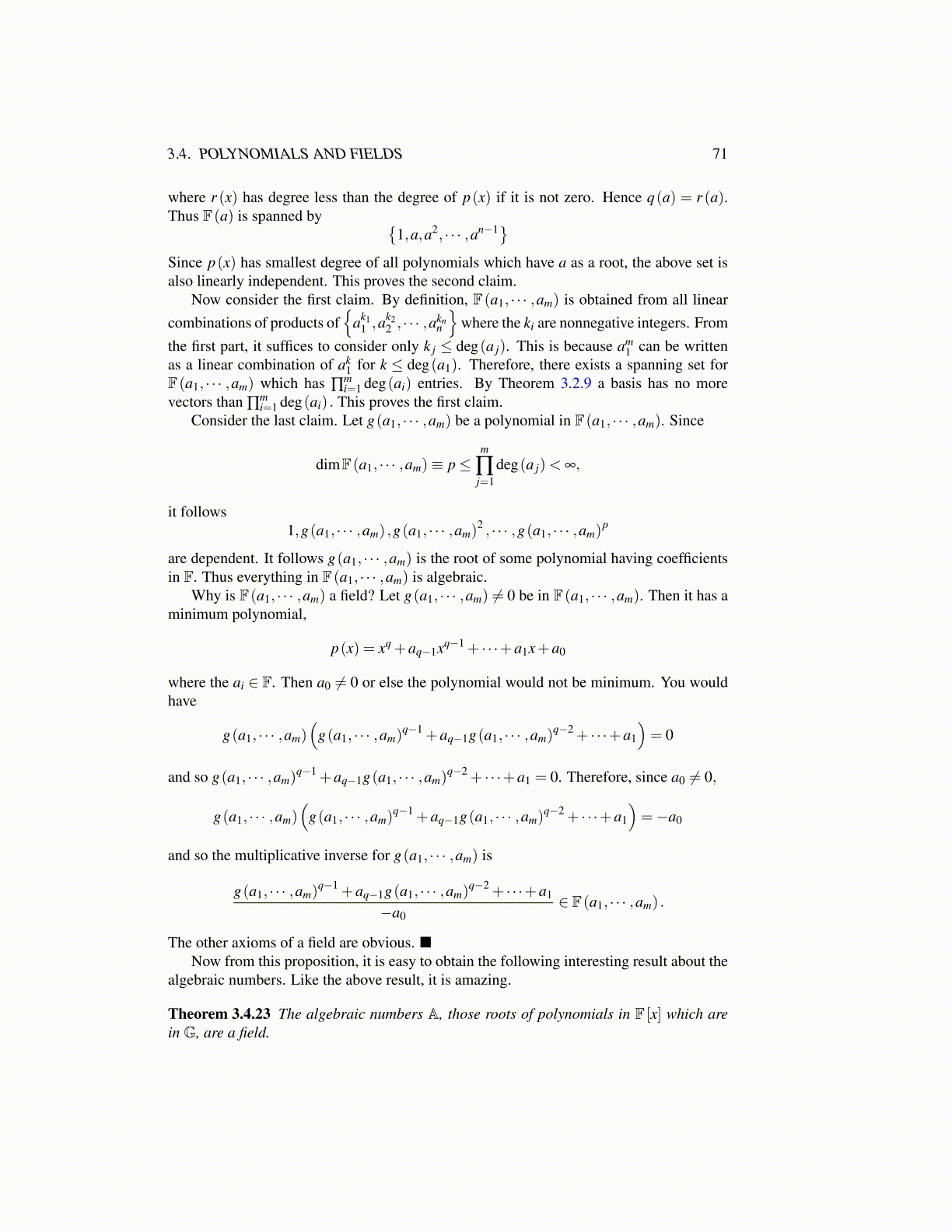
3.4. POLYNOMIALS AND FIELDS 71
where r (x) has degree less than the degree of p(x) if it is not zero. Hence q(a) = r (a).Thus F(a) is spanned by {
1,a,a2, · · · ,an−1}Since p(x) has smallest degree of all polynomials which have a as a root, the above set isalso linearly independent. This proves the second claim.
Now consider the first claim. By definition, F(a1, · · · ,am) is obtained from all linearcombinations of products of
{ak1
1 ,ak22 , · · · ,akn
n
}where the ki are nonnegative integers. From
the first part, it suffices to consider only k j ≤ deg(a j). This is because am1 can be written
as a linear combination of ak1 for k ≤ deg(a1). Therefore, there exists a spanning set for
F(a1, · · · ,am) which has ∏mi=1 deg(ai) entries. By Theorem 3.2.9 a basis has no more
vectors than ∏mi=1 deg(ai) . This proves the first claim.
Consider the last claim. Let g(a1, · · · ,am) be a polynomial in F(a1, · · · ,am). Since
dimF(a1, · · · ,am)≡ p≤m
∏j=1
deg(a j)< ∞,
it follows1,g(a1, · · · ,am) ,g(a1, · · · ,am)
2 , · · · ,g(a1, · · · ,am)p
are dependent. It follows g(a1, · · · ,am) is the root of some polynomial having coefficientsin F. Thus everything in F(a1, · · · ,am) is algebraic.
Why is F(a1, · · · ,am) a field? Let g(a1, · · · ,am) ̸= 0 be in F(a1, · · · ,am). Then it has aminimum polynomial,
p(x) = xq +aq−1xq−1 + · · ·+a1x+a0
where the ai ∈ F. Then a0 ̸= 0 or else the polynomial would not be minimum. You wouldhave
g(a1, · · · ,am)(
g(a1, · · · ,am)q−1 +aq−1g(a1, · · · ,am)
q−2 + · · ·+a1
)= 0
and so g(a1, · · · ,am)q−1 +aq−1g(a1, · · · ,am)
q−2 + · · ·+a1 = 0. Therefore, since a0 ̸= 0,
g(a1, · · · ,am)(
g(a1, · · · ,am)q−1 +aq−1g(a1, · · · ,am)
q−2 + · · ·+a1
)=−a0
and so the multiplicative inverse for g(a1, · · · ,am) is
g(a1, · · · ,am)q−1 +aq−1g(a1, · · · ,am)
q−2 + · · ·+a1
−a0∈ F(a1, · · · ,am) .
The other axioms of a field are obvious. ■Now from this proposition, it is easy to obtain the following interesting result about the
algebraic numbers. Like the above result, it is amazing.
Theorem 3.4.23 The algebraic numbers A, those roots of polynomials in F [x] which arein G, are a field.